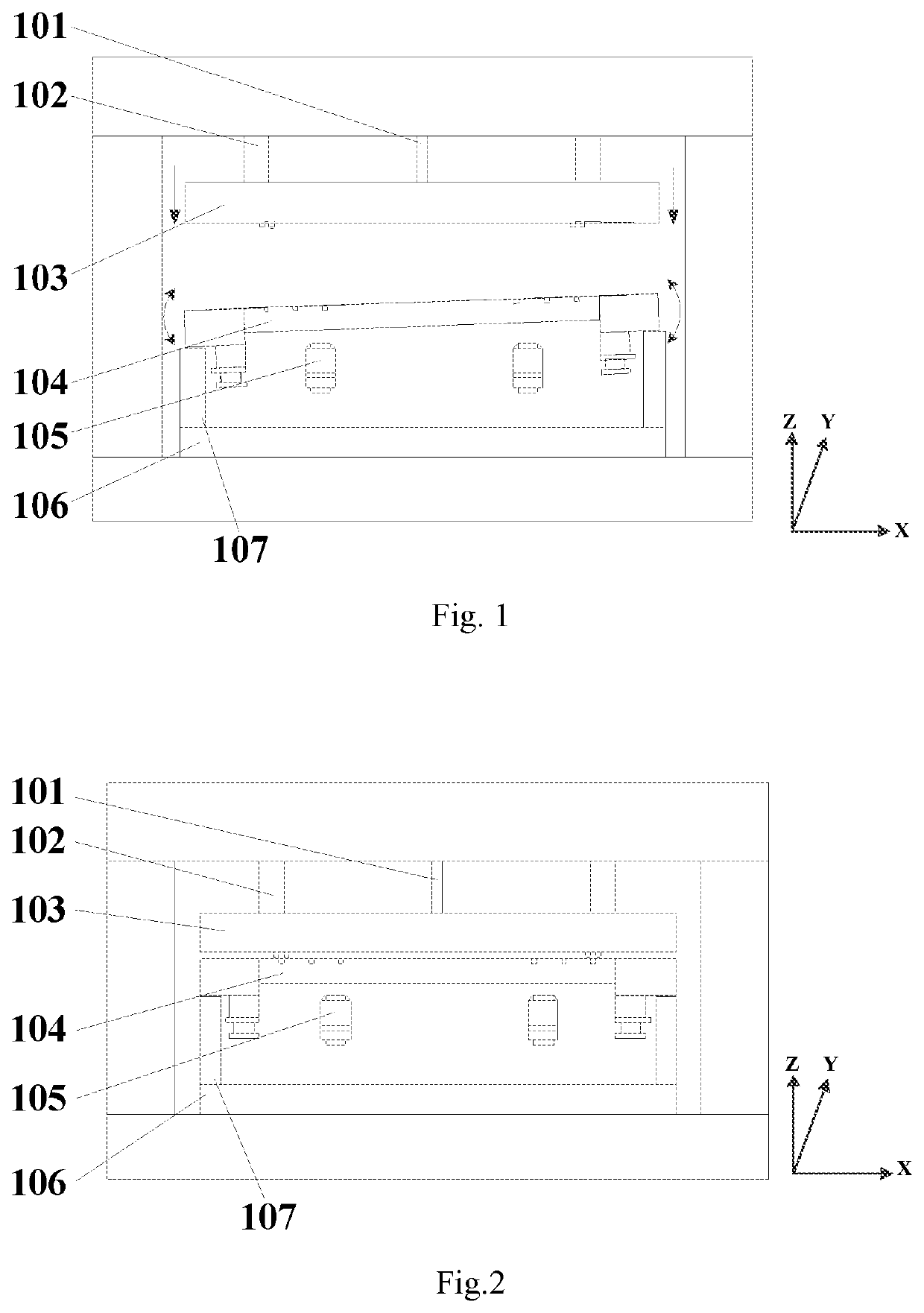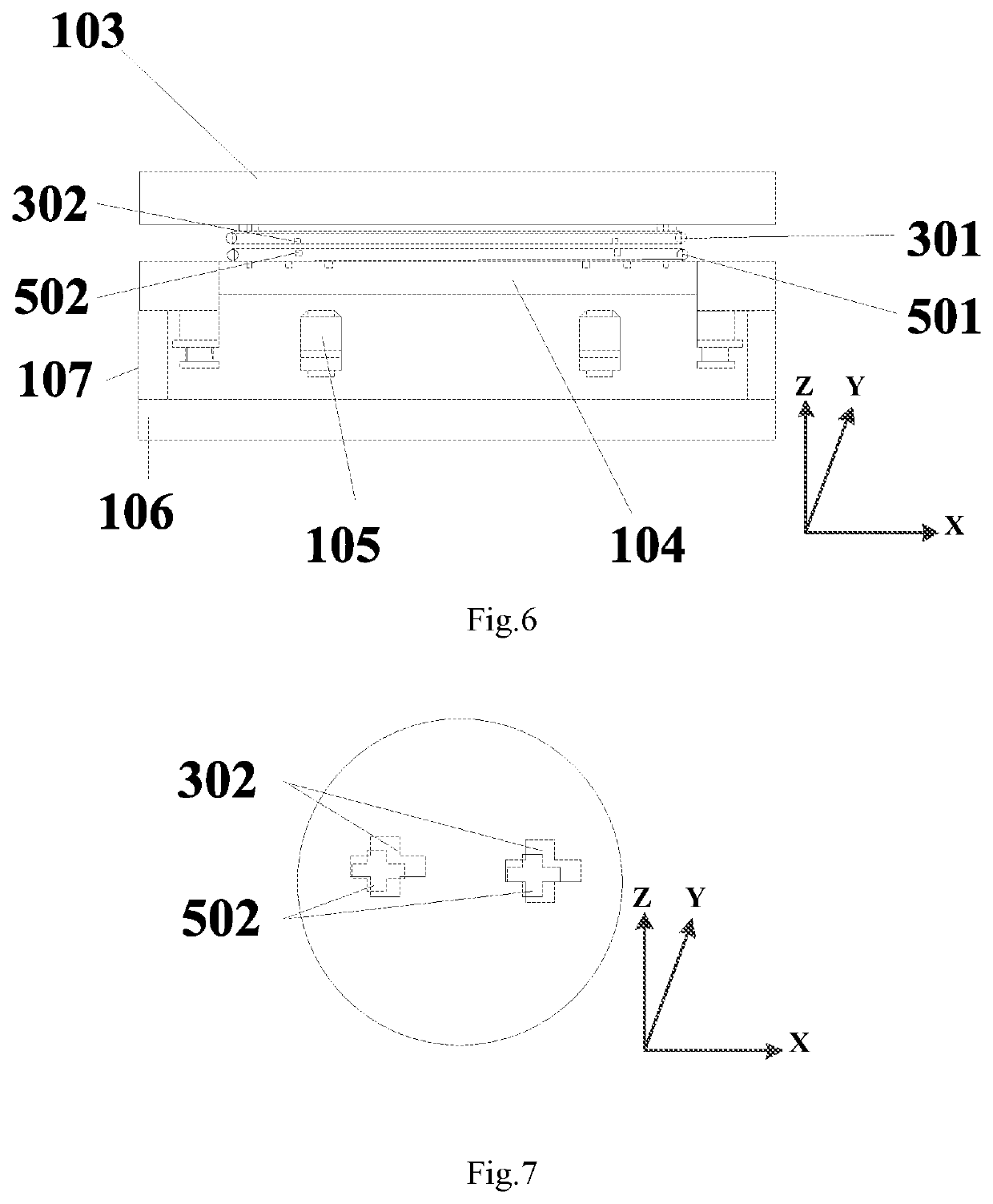Device and method for bonding alignment
a technology of bonding alignment and devices, applied in semiconductor devices, semiconductor/solid-state device details, chemistry apparatus and processes, etc., can solve the problems of affecting the final alignment accuracy, high the inability to control the errors that may arise from the movement of the substrate during the alignment process, so as to reduce the complexity of the associated apparatus, control the global alignment accuracy, and reduce the complexity of the apparatus
- Summary
- Abstract
- Description
- Claims
- Application Information
AI Technical Summary
Benefits of technology
Problems solved by technology
Method used
Image
Examples
embodiment 1
[0046]Referring to FIG. 1, the present invention provides an apparatus for bonding alignment of two substrates. The apparatus for bonding alignment includes a press assembly comprising, from top to bottom, an upper actuator 102, an upper chuck 103 in fixed connection to the upper actuator 102, a lower chuck 104 having a support surface facing toward a support surface of the upper chuck 103, a leveling device 107 in fixed connection to the lower chuck 104 and a lower actuator 106 in fixed connection to the leveling device 107. The upper chuck 103 is electrically connected to a pressure sensor 101 for detecting a pressure applied by the upper chuck 103 to the lower chuck 104. The upper actuator 102 can drive the upper chuck 103 to move vertically.
[0047]Herein, an X-Y-Z three-dimensional coordinate system is defined by an X-axis extending horizontally, a Z-axis extending vertically and a Y-axis extending perpendicular to the X-Z plane defined by the X and Z axes.
[0048]Referring to FIG....
embodiment 2
[0062]This embodiment differs from Embodiment 1 in that the objective lens group 105 is disposed on one side of the upper chuck 103. Referring to FIG. 10, the upper chuck 103 is fixed to the upper actuator 102 and is made of a transparent material allowing the passage of light sources. Similarly, the leveling device 107 is fixedly connected to the lower actuator 106, and the lower chuck 104 is fixed to the leveling device 107. The lower chuck 104 is able to yaw in two degrees of freedom (i.e., Rx and Ry).
[0063]Referring to FIG. 11, the upper chuck 103 moves downward with a constant orientation under the action of the upper actuator 102. Upon the pressure sensor 101 having sensed that a pressure exerted by the upper chuck 103 on the lower chuck 104 reaches a predetermined value, it is determined that a wedge-shaped error has been eliminated, and the upper actuator 102 is then deactivated. The lower chuck 104 maintains this orientation with the aid of the leveling device 107.
[0064]Ref...
PUM
| Property | Measurement | Unit |
|---|---|---|
| pressure | aaaaa | aaaaa |
| altitude | aaaaa | aaaaa |
| height | aaaaa | aaaaa |
Abstract
Description
Claims
Application Information
 Login to View More
Login to View More - R&D
- Intellectual Property
- Life Sciences
- Materials
- Tech Scout
- Unparalleled Data Quality
- Higher Quality Content
- 60% Fewer Hallucinations
Browse by: Latest US Patents, China's latest patents, Technical Efficacy Thesaurus, Application Domain, Technology Topic, Popular Technical Reports.
© 2025 PatSnap. All rights reserved.Legal|Privacy policy|Modern Slavery Act Transparency Statement|Sitemap|About US| Contact US: help@patsnap.com



